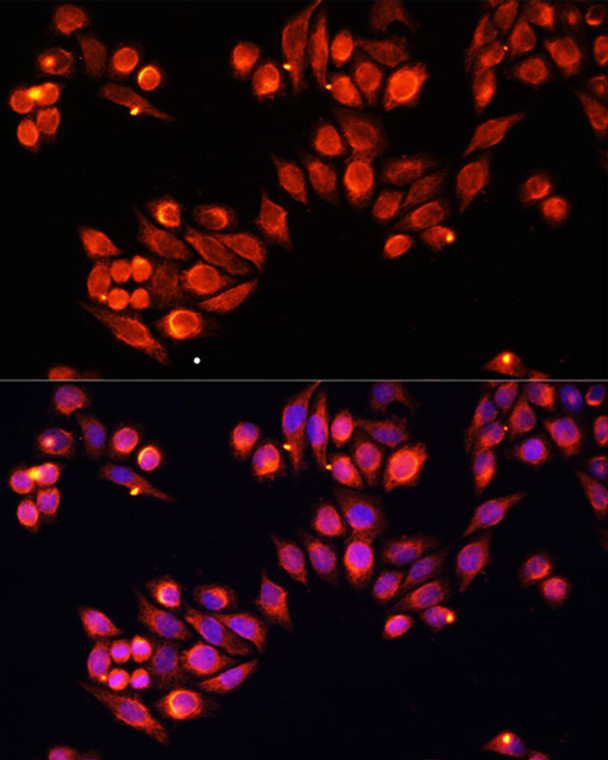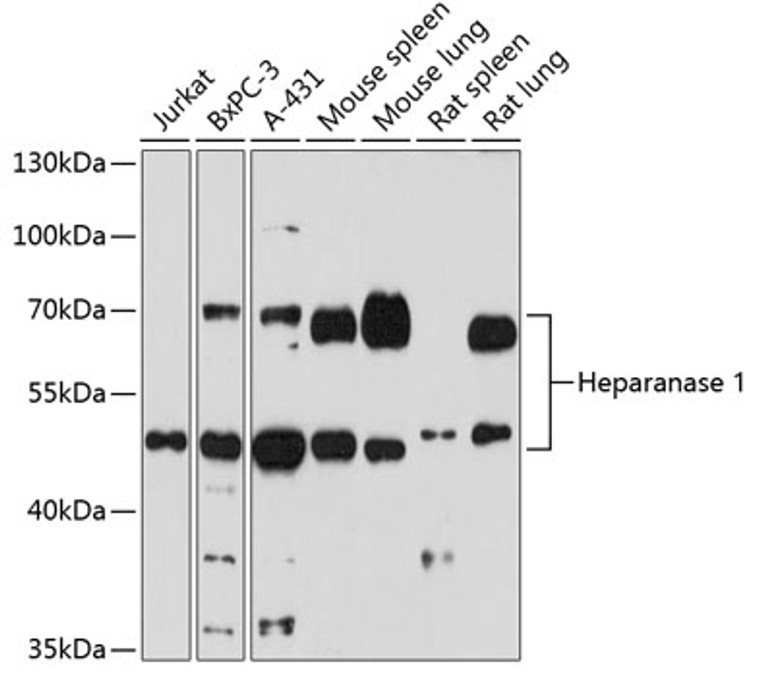| Host: |
Rabbit |
| Applications: |
WB/IHC/IF |
| Reactivity: |
Human/Mouse/Rat |
| Note: |
STRICTLY FOR FURTHER SCIENTIFIC RESEARCH USE ONLY (RUO). MUST NOT TO BE USED IN DIAGNOSTIC OR THERAPEUTIC APPLICATIONS. |
| Short Description: |
Rabbit polyclonal antibody anti-Heparanase 1 (36-543) is suitable for use in Western Blot, Immunohistochemistry and Immunofluorescence research applications. |
| Clonality: |
Polyclonal |
| Conjugation: |
Unconjugated |
| Isotype: |
IgG |
| Formulation: |
PBS with 0.01% Thimerosal, 50% Glycerol, pH7.3. |
| Purification: |
Affinity purification |
| Dilution Range: |
WB 1:500-1:2000IHC-P 1:50-1:200IF/ICC 1:50-1:200 |
| Storage Instruction: |
Store at-20°C for up to 1 year from the date of receipt, and avoid repeat freeze-thaw cycles. |
| Gene Symbol: |
HPSE |
| Gene ID: |
10855 |
| Uniprot ID: |
HPSE_HUMAN |
| Immunogen Region: |
36-543 |
| Immunogen: |
Recombinant fusion protein containing a sequence corresponding to amino acids 36-543 of human Heparanase 1 (NP_001092010.1). |
| Immunogen Sequence: |
QDVVDLDFFTQEPLHLVSPS FLSVTIDANLATDPRFLILL GSPKLRTLARGLSPAYLRFG GTKTDFLIFDPKKESTFEER SYWQSQVNQDICKYGSIPPD VEEKLRLEWPYQEQLLLREH YQKKFKNSTYSRSSVDVLYT FANCSGLDLIFGLNALLRTA DLQWNSSNAQLLLDYCSSKG YNISWELGNEPNSFLKKADI FINGSQLGEDFIQLHKLLRK STFKNAKLYGPDVGQPRRK |
| Tissue Specificity | Highly expressed in placenta and spleen and weakly expressed in lymph node, thymus, peripheral blood leukocytes, bone marrow, endothelial cells, fetal liver and tumor tissues. Also expressed in hair follicles, specifically in both Henle's and Huxley's layers of inner the root sheath (IRS) at anagen phase. |
| Post Translational Modifications | Proteolytically processed. The cleavage of the 65 kDa form leads to the generation of a linker peptide, and 8 kDa and 50 kDa products. The active form, the 8/50 kDa heterodimer, is resistant to degradation. Complete removal of the linker peptide appears to be a prerequisite to the complete activation of the enzyme. N-glycosylated. Glycosylation of the 50 kDa subunit appears to be essential for its solubility. |
| Function | Endoglycosidase that cleaves heparan sulfate proteoglycans (HSPGs) into heparan sulfate side chains and core proteoglycans. Participates in extracellular matrix (ECM) degradation and remodeling. Selectively cleaves the linkage between a glucuronic acid unit and an N-sulfo glucosamine unit carrying either a 3-O-sulfo or a 6-O-sulfo group. Can also cleave the linkage between a glucuronic acid unit and an N-sulfo glucosamine unit carrying a 2-O-sulfo group, but not linkages between a glucuronic acid unit and a 2-O-sulfated iduronic acid moiety. It is essentially inactive at neutral pH but becomes active under acidic conditions such as during tumor invasion and in inflammatory processes. Facilitates cell migration associated with metastasis, wound healing and inflammation. Enhances shedding of syndecans, and increases endothelial invasion and angiogenesis in myelomas. Acts as procoagulant by increasing the generation of activation factor X in the presence of tissue factor and activation factor VII. Increases cell adhesion to the extracellular matrix (ECM), independent of its enzymatic activity. Induces AKT1/PKB phosphorylation via lipid rafts increasing cell mobility and invasion. Heparin increases this AKT1/PKB activation. Regulates osteogenesis. Enhances angiogenesis through up-regulation of SRC-mediated activation of VEGF. Implicated in hair follicle inner root sheath differentiation and hair homeostasis. |
| Protein Name | HeparanaseEndo-GlucoronidaseHeparanase-1Hpa1 Cleaved Into - Heparanase 8 Kda Subunit - Heparanase 50 Kda Subunit |
| Database Links | Reactome: R-HSA-2024096Reactome: R-HSA-6798695 |
| Cellular Localisation | Lysosome MembranePeripheral Membrane ProteinSecretedNucleusProheparanase Is Secreted Via Vesicles Of The GolgiInteracts With Cell Membrane Heparan Sulfate Proteoglycans (Hspgs)Endocytosed And Accumulates In EndosomesTransferred To Lysosomes Where It Is Proteolytically Cleaved To Produce The Active EnzymeUnder Certain StimuliTransferred To The Cell SurfaceAssociates With Lipid RaftsColocalizes With Sdc1 In Endosomal/Lysosomal VesiclesAccumulates In Perinuclear Lysosomal VesiclesHeparin Retains Proheparanase In The Extracellular Medium |
| Alternative Antibody Names | Anti-Heparanase antibodyAnti-Endo-Glucoronidase antibodyAnti-Heparanase-1 antibodyAnti-Hpa1 Cleaved Into - Heparanase 8 Kda Subunit - Heparanase 50 Kda Subunit antibodyAnti-HPSE antibodyAnti-HEP antibodyAnti-HPA antibodyAnti-HPA1 antibodyAnti-HPR1 antibodyAnti-HPSE1 antibodyAnti-HSE1 antibody |
Information sourced from Uniprot.org
12 months for antibodies. 6 months for ELISA Kits. Please see website T&Cs for further guidance









